31st Annual Study of Logistics and Transportation Trends: Meeting the need for talent
While the turbulent market has created headaches for shippers, carriers, and service providers, our study also focused on one of the most critical threats facing today’s logistics and supply chain leaders: people.
Weary from two years of disruption, some are even questioning if the current state of many supply chains is simply the “new normal” (#8 on the banished word list).
Prior to the last two years, few outside the industry were even interested in supply chains. So, the frustration is understandable. We have grown increasingly accustomed to the convenience of selecting from a nearly unlimited array of products, purchasing with a single click, and having products delivered the same or next day.
Disruptions that began with the COVID-19 outbreak were, for many, the first experience with widespread shortages, limited product selections, or extended delivery times. With continued uncertainty, rising consumer prices, and ongoing disruptions, it’d reasonable to wonder what might happen next and question if supply chains will ever return to “normal.”
Talent Needs
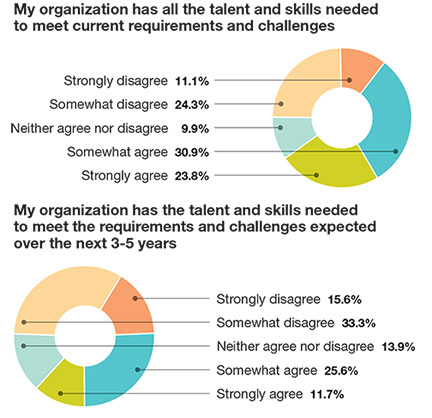
Perhaps companies will instead seize this opportunity to longstanding issues and vulnerabilities and adapt logistics and supply chain operations to be more resilient, responsive, and efficient.
Drawing on responses from the more than 300 logistics and supply chain professionals that participated, the “31st Annual Study of Logistics and Transportation Trends” revealed impacts that the turbulent market has had on shippers, carriers and service providers. The study also focused on one of the most critical issues and threats facing today’s logistics and supply chain leaders: people.
Turbulent times
Managing the supply chain continues to be a challenge. Respondents to the survey reported a greater than 6% increase in revenue growth and 4% increase in profitability in the previous year, despite a more than 3% decrease in customer satisfaction.
The results are consistent with the most recent “State of Logistics Report” that suggested the historically lucrative spot market rates helped boost carrier and service provider revenues, but frequent reallocation of assets to more profitable or urgent loads created delays and affected customer service.
Job Factor-insights into importance
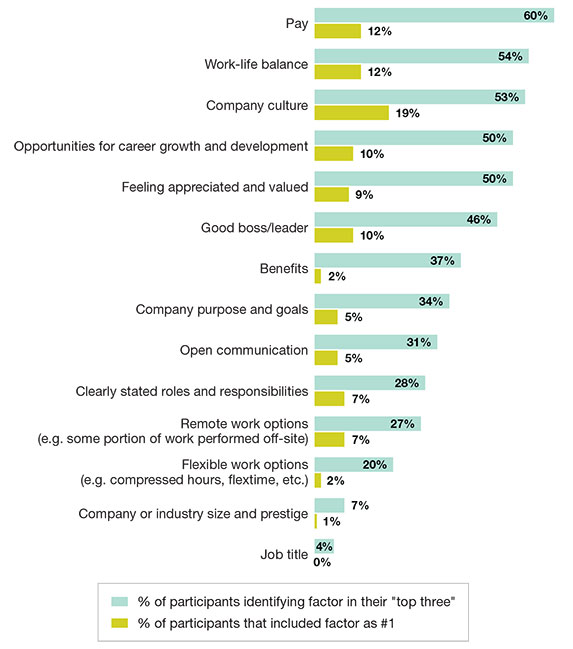
Talent Challenge (How difficult do you expect it will be for your organization to fill its talent and skill needs during the upcoming year?)

% transportation spend by mode
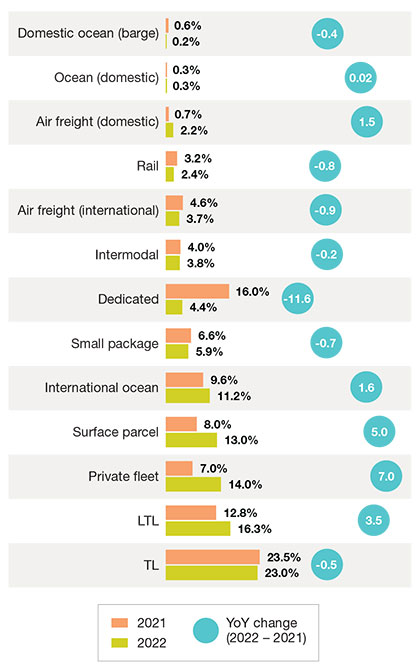
Transportation spending also reflected the dynamics created by market forces over the last two years. Shippers varied spending to adapt to conditions created by capacity constraints and to meet customer needs. Spending for both truckload and less-than-truckload increased over the last two years. The results also reflect increased spending for private fleets as shippers looked to reduce costs and ensure capacity.
Help wanted
Obtaining, training, and retaining talent is another critical issue facing logistics and supply chain leaders and businesses. People are the most important link in the supply chain, and without a doubt, supply chains desperately need people. According to Abe Eshkenazi, CEO of the Association for Supply Chain Management (ASCM): “Talent was a serious situation prior to the pandemic. It has become a crisis since…The pandemic exposed the shortage at every level from the warehouse to the top.”
In this year’s “Study of Logistics and Transportation Trends,” only 23.7% of respondents agreed that their organization has the talent and skills needed to meet current requirements and challenges, and 74% expected it to be difficult or extremely difficult to fill those needs in the upcoming year.
Digging deeper into the specific skill needs, the study found both general laborer and skilled positions were difficult to fill. As we found this year, 81% of respondents indicated it was either “somewhat” or “extremely difficult” to fill general laborer positions, while 86% reported difficulty filling driver and equipment operator related positions.
Manufacturing and service-related positions were equally challenging, with 90% of respondents reporting difficulty filling mechanic and technician type positions, and 84% reporting difficulty filling positions for manufacturing trades such as welders and machinists.
Skill gap
Going forward, the talent picture appears even more challenging. As technology rapidly transforms logistics and supply chain operations, the skills needed in the future will likely be much different than the skills required today.
Unfortunately, less than 12% of study respondents “strongly agree” that their organization has the talent and skills needed to meet the requirements and challenges expected in the next 3 years to 5 years.
Respondents expect Internet of Things-based technologies to make the most significant impact on logistics and supply chains over the next 3 years to 5 years. A number of the other top ranked technologies could help mitigate talent shortages and skill gaps.
For example, robotics and automation promise to make supply chains more efficient and less labor intensive, while Artificial Intelligence can enhance human performance and decision making.
Technology alone will not resolve the logistics and supply chain talent issues; in fact, technology is actually a double-edged sword. New skillsets will be needed as technologies are integrated into supply chains, making it even more critical to recruit, train and retain top talent. As we found in this year’s survey, only 6.75% of respondents “strongly agree” that adopting new technologies will reduce the dependence on employee talent.
Almost 80% of respondents “agree” or “strongly agree” that the number of technologies employees must use is increasing, while nearly 55% “agree” or “strongly agree” that their current employees lack the skills to use the technologies effectively. Interestingly, almost 70% of respondents “agree” or “strongly agree” that adopting new technologies may help their organization attract and recruit new talent.
L&T jobs compared to jobs in other industries
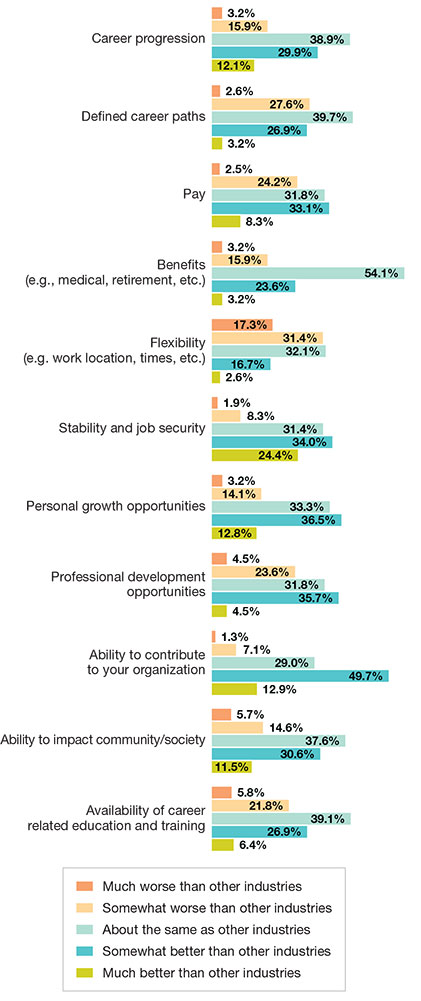
A perception problem
A key to tackling the logistics and supply chain talent threat will be improving the perception of logistics and transportation careers. We conducted a number of interviews with industry professionals to help inform and shape this year’s study.
The professionals were asked to share a question that they would most like to see included and answered in the survey. Every professional suggested some form of a question about the perceptions of logistics-related careers, suspecting that negative perceptions of the industry would be the major barriers to attracting top talent.
Technology and Talent
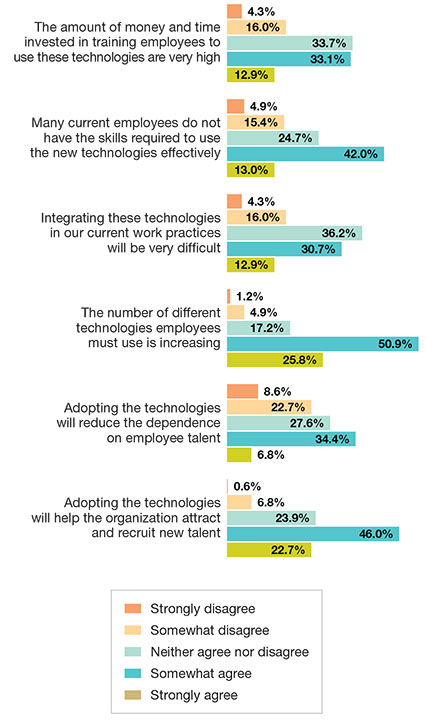
In response, each participant was asked to consider a series of job factors and then share their perception of how logistics and transportation jobs compared to jobs in other industries for each of the factors.
Of the job factors considered, over 62% of respondents perceived the “ability to contribute to your organization” was “better” or “much better” for logistics and transportation jobs than jobs in other careers. Almost 59% believed that logistics and transportation jobs offered greater stability and job security.
Respondents also perceived logistics and transportation careers to be “better” or “much better” for a number of other factors, including personal growth opportunities; career progression; ability to affect society; pay; and professional development opportunities.
Flexibility was the only factor respondents perceived as being “worse” or “much worse” for logistics and transportation jobs (48.7%). For the remaining three factors, availability of education and training, defined career paths, and benefits, logistics and transportation jobs were perceived as being about the same as jobs in other industries.
Difficulty Filling full-time positions
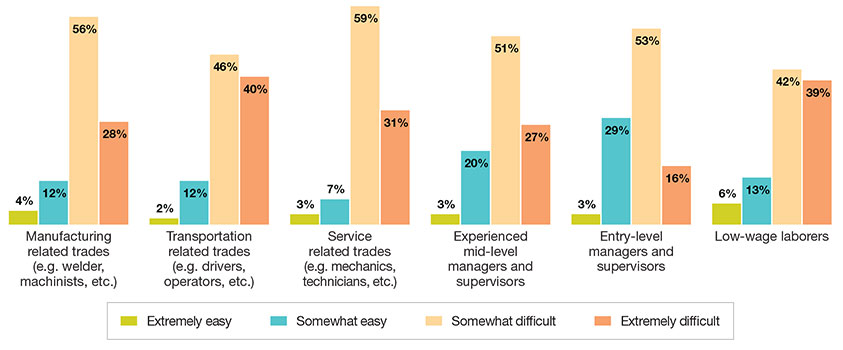
The results suggest logistics and transportation jobs offer advantages over jobs in other industries that can be used to attract and retain talent. Results also suggest opportunities to improve or further differentiate logistics and transportation jobs from jobs in other industries.
It’s important to note the majority of respondents currently work in logistics related careers, and thus the perceptions are likely biased. This is especially noteworthy considering most have experience in the industry and there were not substantial differences between the positive and negative perceptions.
To help address some of this potential bias, respondents were also asked to indicate their level of agreement with the following statement: “I am very likely to encourage my child (or child of a close friend) to pursue a career in transportation or logistics.”
Only 19.38% of respondents strongly agreed they would encourage their child (or child of a friend) to pursue a career in transportation or logistics. Again, we acknowledge there are likely factors influencing the responses that are not accounted for in the survey.
However, the results do suggest that there’s an opportunity—and need—to improve perceptions of logistics and transportation jobs and help make the industry more attractive to an increasingly competitive job market.
The path forward
The “31st Annual Study of Logistics and Transportation Trends” found the industry a little battered and bruised from two years of unprecedented disruptions and market conditions. However, the people behind these operations persevered and continued to deliver.
Yet, the pressure put on the most important link in the supply chain comes at a cost. Retaining and recruiting top talent will be increasingly difficult. To succeed, organizations must take steps to adapt to the new labor environment and develop a strategy to tackle the talent threat.
Complaining is not an effective talent strategy. There are many factors driving the current labor market, and just as many opinions about why it’s
so difficult to find skilled workers. It can be tempting to blame the labor shortage on simply a lack of work
ethic or motivation.
Indeed, the current labor situation is far more complex. How people think about work is also changing to a “what I do” perspective instead of a source of identity and “who I am.” These shifts have significant implications for employers, and how we do and define work needs to be re-evaluated.
Talent strategies need to be more employee-centric and allow for the flexibility and work-life balance that employees value.
Strategies for Finding talent (% responses that included strategy)
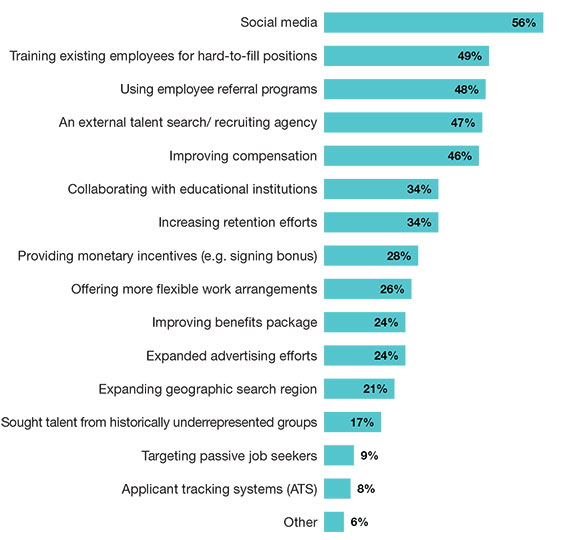
As we’re finding, few industries offer the same career opportunities as logistics and supply chain. Professionals can opt to work in a variety of environments and industries. Logistics and supply chain careers offer stable employment, enticing pay, and opportunities for personal growth and development.
Unfortunately, the industry still struggles to attract the needed talent and when asked, only 19% of survey respondents indicated that they would even encourage their child to pursue a career in logistics.
To tackle the talent threat, the industry must confront negative perceptions and work to enhance the appeal of logistics and supply chain-related careers. •













